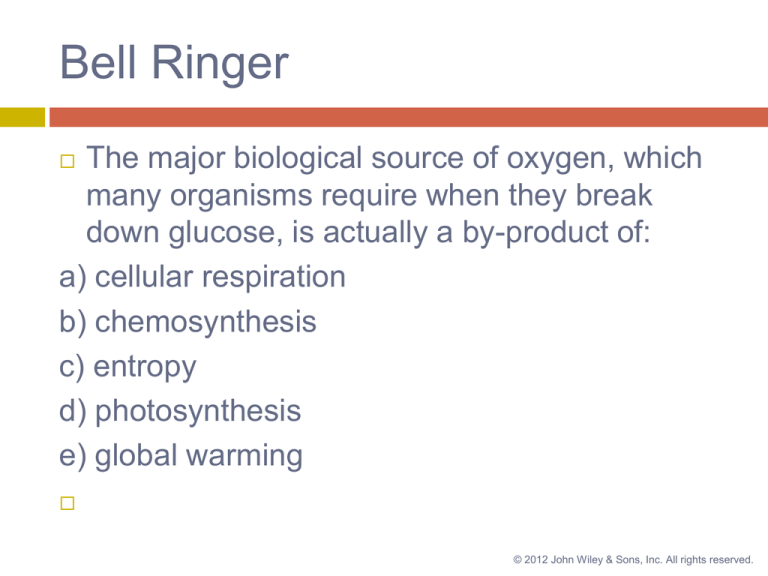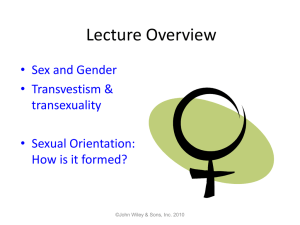
Bell Ringer
The major biological source of oxygen, which
many organisms require when they break
down glucose, is actually a by-product of:
a) cellular respiration
b) chemosynthesis
c) entropy
d) photosynthesis
e) global warming
© 2012 John Wiley & Sons, Inc. All rights reserved.
Answer:
Photosynthesis
Unit 2 exam
© 2012 John Wiley & Sons, Inc. All rights reserved.
7
Human Health and Environmental Toxicology
Overview of Chapter 7
Human Health
In
developed countries
In developing countries
Environmental Pollution and Disease
Environmental
Contaminants
Endocrine Disrupters
Determining Health Effects of Pollutants
Ecotoxicology
Risk Assessment
© 2012 John Wiley & Sons, Inc. All rights reserved.
Human Health
Two indicators of human health
Life
expectancy - how long people are expected to
live
Infant mortality - how many children die before
age of 1 year
Vary greatly between
countries
Developed
countries
Developing countries
© 2012 John Wiley & Sons, Inc. All rights reserved.
Health in Highly Developed Countries
Health is generally good in these countries
Average life expectancy
Men
= 75 years
Women = 80 years
Leading causes of death in US
Cardiovascular
disease, Cancer, Lung Disease
Premature deaths caused by lifestyle
Poor
diet, Lack of exercise, Smoking, Obesity
© 2012 John Wiley & Sons, Inc. All rights reserved.
Health in Developing Countries
Biggest problems
Malnutrition,
unsafe water, poor sanitation
Life Expectancy
Overall
is 65 years
Very poorest developing countries = 45 years
Due
to AIDS epidemics
Childhood mortality is high
Diarrheal
diseases
Malnutrition
Malaria
AIDS/HIV
© 2012 John Wiley & Sons, Inc. All rights reserved.
Emerging and Reemerging Diseases
Emerging Disease - not previously observed in
humans
Usually
jumps from animal host
Ex: AIDS, lime disease, West Nile Virus
Reemerging Disease existed in the past and
are recently increasing in incidence
Ex:
tuberculosis, yellow fever, malaria
© 2012 John Wiley & Sons, Inc. All rights reserved.
Reasons for Emergence/Reemergence
Evolution of disease so it transitions to human
host
Evolution of antibiotic resistance in disease
Urbanization and overcrowding
Increased pop. of elderly - susceptible to disease
Pollution and environmental degradation
Growth in international travel and commerce
Poverty and social inequality
© 2012 John Wiley & Sons, Inc. All rights reserved.
Environmental Pollution and Disease
Pathways of
Pollution
Often difficult to
link pollutants to
their effects on
people
Persistence
Bioaccumulation
& magnification
© 2012 John Wiley & Sons, Inc. All rights reserved.
Persistence
A characteristic of certain chemicals that are
extremely stable and may take many years to
be broken down into simpler forms by natural
processes
Synthetic
Ex:
chemicals (those not found in nature)
DDT
Natural decomposers (bacteria) have not
evolved a way to break it down
© 2012 John Wiley & Sons, Inc. All rights reserved.
Bioaccumulation
The buildup of a persistent toxic substance in
an organism’s body, often in fatty tissues
Synthetic
chemical do not metabolize well
They remain in the body for extended periods of
time
© 2012 John Wiley & Sons, Inc. All rights reserved.
Biomagnification
The increased
concentration of toxic
chemicals in the tissues
of organisms that are at
higher levels in food webs
Diagram (right) is
example of
biomagnification of DDT
© 2012 John Wiley & Sons, Inc. All rights reserved.
Effect of DDT on Bald Eagles
© 2012 John Wiley & Sons, Inc. All rights reserved.
Endocrine Disrupters
A chemical that mimics or interferes with the
actions of the endocrine system in humans and
wildlife
Examples include:
PCBs,
Dioxins
Heavy metals – lead and mercury
DDT
Animals exposed to these chemicals have
altered reproductive development and are
often sterile
© 2012 John Wiley & Sons, Inc. All rights reserved.
Endocrine Disrupters
Case Study: 1980 chemical spill into Lake
Apopka, FL
Male
alligators began to exhibit low testosterone
levels and high estrogen levels
© 2012 John Wiley & Sons, Inc. All rights reserved.
Endocrine Disrupters and Humans
Infertility and hormonally related cancers are
increasing
Breast
cancer and testicular cancer
Phthalates have been implicated as potential
endocrine disrupters
Common
ingredient in: cosmetics, fragrances, nail
polish, medication, toys, food packaging
© 2012 John Wiley & Sons, Inc. All rights reserved.
Determining Health Effects of Pollutants
Toxicology is the study of the effect of toxicants
on the human body
Toxicant
- chemical with adverse human health
effects
Toxicity measured by dose and response
Dose:
amount that enters that body of an exposed
organism
Response: the amount of damage caused by a
specific dose
© 2012 John Wiley & Sons, Inc. All rights reserved.
Toxicology
Acute toxicity
Adverse
effects occur within a short period after
exposure to toxin
Chronic toxicity
Adverse
effects occur some time after exposure,
or after prolonged exposure to toxin
© 2012 John Wiley & Sons, Inc. All rights reserved.
Toxicity
LD50
Lethal
dose to
50% of the test
organisms
Smaller the LD50,
the more lethal the
chemical
Determined for all
new synthetic
chemicals
© 2012 John Wiley & Sons, Inc. All rights reserved.
Toxicity
ED50
Effective
dose to 50% of the test organisms
ED50 causes 50% of the population to exhibit
whatever effect is under study
Dose-Response Curve
Illustrates
the effect of different doses on a
population
Threshold Level
Maximum
dose with no measurable effects
© 2012 John Wiley & Sons, Inc. All rights reserved.
Toxicity: ED50
© 2012 John Wiley & Sons, Inc. All rights reserved.
Children and Chemical Exposure
Children more susceptible
to chemicals
Weigh
less than adults
Bodies are still developing
Play on floors and lawns
Put things into their mouths
Diagram (right)
Children
in foothills not
exposed to pesticides
Children in valley were
exposed
© 2012 John Wiley & Sons, Inc. All rights reserved.
Identifying Cancer Causing
Substances
Toxicologist
Dose
rats with varying levels of chemicals to see
if they develop cancer
Difficult to extrapolate results to humans
Epidemiologists
Look
at historical exposure of groups of humans
See if exposed group have increased cancer rate
© 2012 John Wiley & Sons, Inc. All rights reserved.
Chemical Mixtures
Most studies look at one chemical, but humans
tend to be exposed to chemical mixtures
Ex:
automobile exhaust
Chemical Mixtures interact by
Additivity
Synergy
Antagonism
These studies are expensive and take a while
to complete
© 2012 John Wiley & Sons, Inc. All rights reserved.
Ecotoxicology
Dilution Paradigm is not valid
“Dilution
Boomerang Paradigm is accepted
“What
you”
is the solution to pollution”
you throw away can come back and hurt
Ecotoxicology
The
study of contaminants in the biosphere and
their harmful effects on ecosystems
Helps policy makers determine costs and benefits
of industrial and technological “advances”
© 2012 John Wiley & Sons, Inc. All rights reserved.
Case Study: The Ocean
Land based nutrient and
pollution runoff into ocean
is affecting
microorganisms
Ex: Red Tide
Red
pigmented poisonous
algal blooms
Toxins kill off fish and
make humans sick
© 2012 John Wiley & Sons, Inc. All rights reserved.
Risk Assessment
Risk- probability that a particular adverse
effect will result from some exposure or
condition
We assess risk daily with four steps
1.
2.
3.
4.
Hazard identification
Dose response assessment
Exposure assessment
Risk characterization
Precautionary Principle
No action should be taken when science is
inconclusive
© 2012 John Wiley & Sons, Inc. All rights reserved.
Risk Assessment
© 2012 John Wiley & Sons, Inc. All rights reserved.
Ecological Risk Assessment
Difficult to assess because effect occur at wide
range of scales
Individual
plants and animals
Ecological communities over wide regions
Human-induced environmental stressors also
range greatly
There is a need to quantify risks to the
environment
© 2012 John Wiley & Sons, Inc. All rights reserved.









